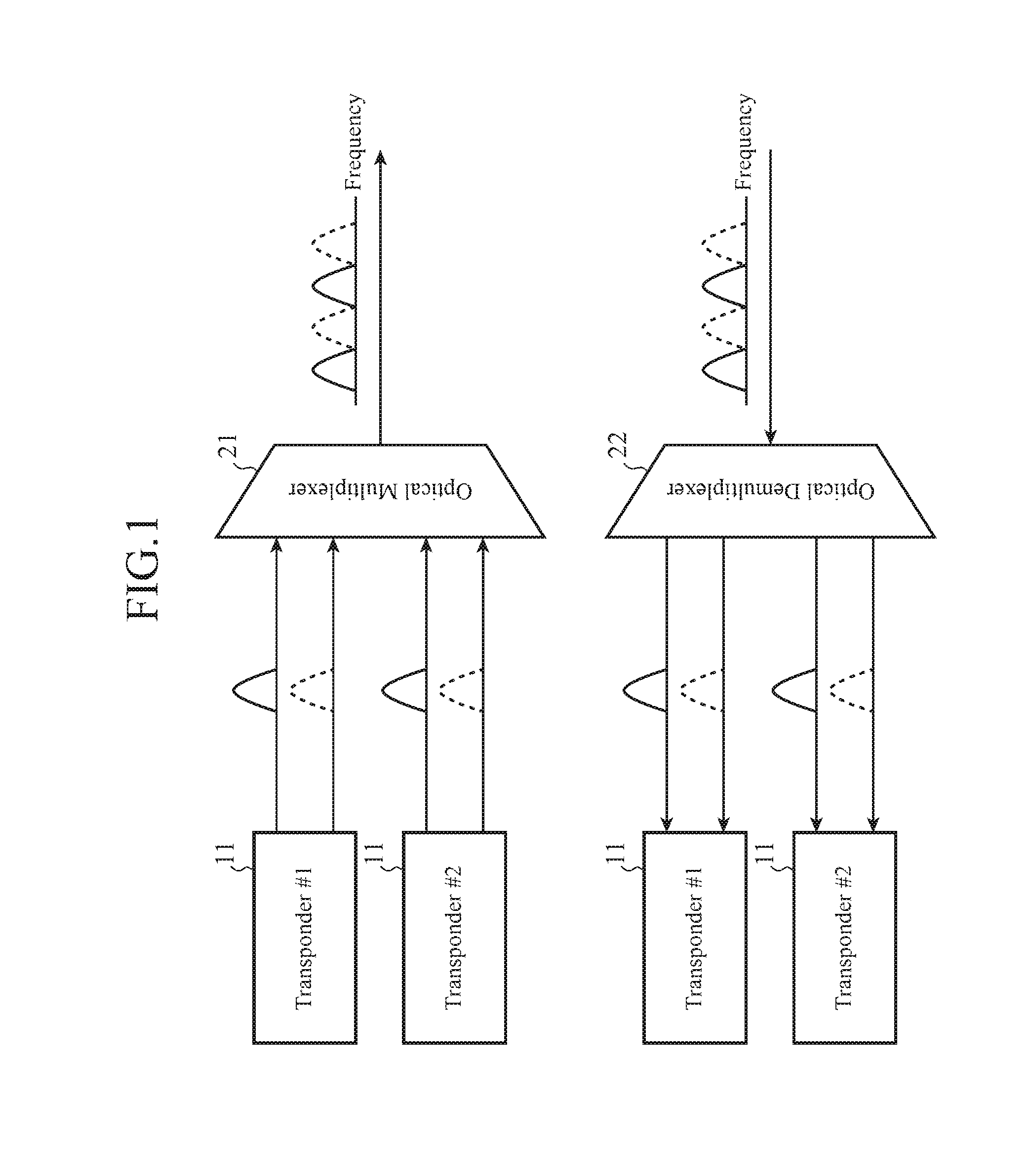Wavelength multiplexing transmission system
a transmission system and wavelength technology, applied in the field of wavelength multiplexing transmission systems, can solve the problems of limiting the power of transmission lights, increasing the spectral width of each transmission light, and increasing the cost of transmission equipment, so as to reduce the degradation of transmission characteristics and simple and low-cost configuration
- Summary
- Abstract
- Description
- Claims
- Application Information
AI Technical Summary
Benefits of technology
Problems solved by technology
Method used
Image
Examples
embodiment 1
[0024]FIG. 1 is a diagram showing an outline of a wavelength multiplexing transmission system according to Embodiment 1 of the present invention.
[0025]In the wavelength multiplexing transmission system according to the present invention, as shown in FIG. 1, a function of performing multiplexing / demultiplexing on carriers (light signals) is disposed in, not in each of transponders 11, but in an optical multiplexing and demultiplexing device 2 (an optical multiplexer 21 and an optical demultiplexer 22) disposed outside the transponders. As a result, there can be provided a simple and low-cost system having a configuration which, instead of employing twice as many tunable filters as the number of carriers, typical interleaver and AWG (Arrayed-Waveguide Gating) can be employed as an alternative.
[0026]Further, according to Embodiment 1, in order to prevent degradation in transmission characteristics due to a power difference among the carriers within the AWG, a function of monitoring the...
embodiment 2
[0044]In Embodiment 1, the case of having a function of, in order to prevent, degradation in the transmission characteristics due to a difference in power among the carriers within the AWG, monitoring the BER of each carrier and controlling the VOAs 23 in such a way that the sum total of the BERs becomes small is shown. In contrast with this, in Embodiment 2, a case of having a function of controlling the polarization of each of carriers so as to deviate the polarizations of the carriers from one another at equal intervals, thereby suppressing a nonlinear penalty will be shown.
[0045]FIG. 3 is a diagram showing the configuration of a wavelength multiplexing transmission system according to Embodiment 2 of the present invention. In FIG. 3, only the configuration of a transmit side, which is included in the configuration of the wavelength multiplexing transmission system, is illustrated. The wavelength multiplexing transmission system according to Embodiment 2 shown in FIG. 3 is a one ...
embodiment 3
[0049]In Embodiment 1, the case of having a function of, in order to prevent degradation in the transmission characteristics due to a difference in power among the carriers within the AWG, monitoring the BER of each carrier and controlling the VOAs 23 in such a way that the sum total of the BERs becomes small is shown. In contrast with this, in Embodiment 3, a case of having a function of monitoring the modulation timing of each of carriers and controlling the modulation timing so as to shift the modulation timings of the carriers relative to one another, thereby suppressing a nonlinear penalty will be shown.
[0050]FIG. 4 is a diagram showing the configuration of a wavelength multiplexing transmission system according to Embodiment 3 of the present invention. In FIG. 4, only the configuration of a transmit side, which is included in the configuration of the wavelength multiplexing transmission system, is illustrated. The wavelength multiplexing transmission system according to Embodi...
PUM
 Login to View More
Login to View More Abstract
Description
Claims
Application Information
 Login to View More
Login to View More - R&D
- Intellectual Property
- Life Sciences
- Materials
- Tech Scout
- Unparalleled Data Quality
- Higher Quality Content
- 60% Fewer Hallucinations
Browse by: Latest US Patents, China's latest patents, Technical Efficacy Thesaurus, Application Domain, Technology Topic, Popular Technical Reports.
© 2025 PatSnap. All rights reserved.Legal|Privacy policy|Modern Slavery Act Transparency Statement|Sitemap|About US| Contact US: help@patsnap.com



